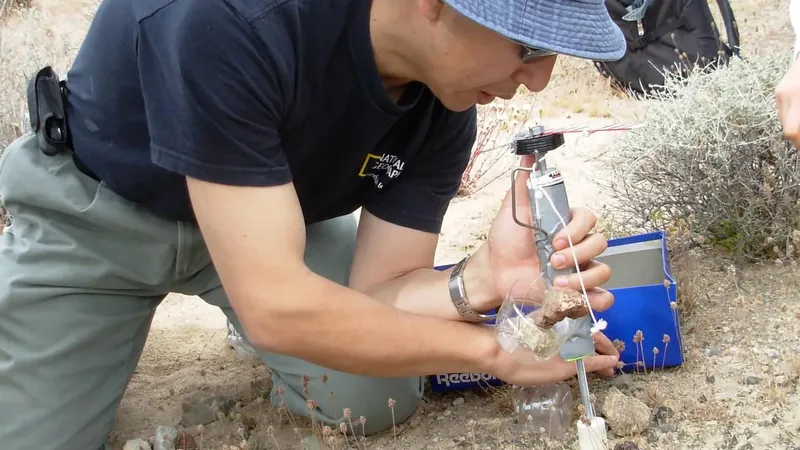
Unlocking the Code: Revolutionary Tool Transforms Complex Cell Data Analysis
2025-05-22
Author: Sarah
Picture trying to assemble a jigsaw puzzle with thousands of scattered pieces, each one unique and confusing. For biologists, this is the reality when sifting through massive datasets derived from experiments that profile thousands of individual cells. The question they face: how to turn raw genomic information into meaningful insights about human health and disease?
Until now, researchers have attempted to categorize cell types, akin to sorting puzzle pieces by color. However, the lack of standardized criteria across studies has left scientists baffled, unable to effectively compare their findings.
Introducing CellWalker2: A Game-Changer in Cell Typing
Now, a groundbreaking computational tool named CellWalker2, developed by the team at Gladstone Institutes, is taking the guesswork out of cell data interpretation. This innovative method not only reveals how cell types are interconnected but also identifies groupings that could significantly impact health, offering a clearer picture of the cells at play.
Katie Pollard, Ph.D., the study's lead author and director of the Gladstone Institute of Data Science and Biotechnology, emphasizes the tool’s capabilities. "Previous approaches overlooked critical relationships between cell types. CellWalker2 recognizes that some types are closely related, like siblings, while others are more distantly related," she explains.
Revealing Hidden Connections Among Cell Types
CellWalker2 addresses the challenge of distinguishing between superficially similar cell types—like immature and mature neurons—by utilizing a hierarchical approach to categorization. Much like sorting puzzle pieces into broad categories before diving into specifics, this algorithm ensures accurate identification of cell types based on genetic data.
If it encounters genomic data from a new study, CellWalker2 will either determine the exact cell type or provide a broader classification, thus enhancing clarity in data analysis.
Beyond Just Labels: Uncovering Biological Insights
In this rapidly advancing field of single-cell data analysis, CellWalker2's implications are profound. Utilizing data from the cutting-edge technique known as "single-cell ATAC-seq," which reveals which DNA regions are active, Pollard’s team is on a quest to decode the complexities of cell behavior.
CellWalker2 initially emerged through a collaboration with Pawel Przytycki, Ph.D. When both were at Gladstone, they created the original version to streamline the analysis of challenging ATAC-seq data, linking it with RNA sequencing for a clearer interpretation of gene activity.
Charting Unknown Territories: Comparing Across Studies and Species
By expanding this initial vision, CellWalker2 now connects various data types to generate significant biological insights. It's akin to glimpsing the puzzle's image on its box, showing which DNA regulatory elements are active in each cell type and quantifying the relationships among datasets.
This transformative tool enables scientists to investigate diseases like autism and schizophrenia by linking regulatory DNA to specific cellular functions.
Revolutionizing Research: A Powerful Resource for Scientists Everywhere
To showcase CellWalker2's capabilities, Pollard and her team applied it to analyze complex datasets from human immune cells, which were generated in different labs with varying methodologies. "Such comparisons were previously arduous due to inconsistent naming conventions, but CellWalker2 built a statistical map to align cell types across studies," notes Hu.
Further investigations allowed them to pinpoint regulatory DNA regions specific to immune cells, enhancing their understanding of genetic influence on cell behavior.
Open for Innovation: CellWalker2 Available for All Researchers
With CellWalker2 already available online for free use, complete with documentation and examples, this tool is set to revolutionize how researchers explore and interpret complex cell data. Pollard envisions using it to demystify the genomic factors associated with conditions like heart disease and mental health disorders.
"We’re entering an era where it's possible to link disease-associated variants to the regulatory programs and cell types they affect," concludes Pollard. With CellWalker2, we are one step closer to understanding the intricate puzzle of human health.



 Brasil (PT)
Brasil (PT)
 Canada (EN)
Canada (EN)
 Chile (ES)
Chile (ES)
 Česko (CS)
Česko (CS)
 대한민국 (KO)
대한민국 (KO)
 España (ES)
España (ES)
 France (FR)
France (FR)
 Hong Kong (EN)
Hong Kong (EN)
 Italia (IT)
Italia (IT)
 日本 (JA)
日本 (JA)
 Magyarország (HU)
Magyarország (HU)
 Norge (NO)
Norge (NO)
 Polska (PL)
Polska (PL)
 Schweiz (DE)
Schweiz (DE)
 Singapore (EN)
Singapore (EN)
 Sverige (SV)
Sverige (SV)
 Suomi (FI)
Suomi (FI)
 Türkiye (TR)
Türkiye (TR)
 الإمارات العربية المتحدة (AR)
الإمارات العربية المتحدة (AR)